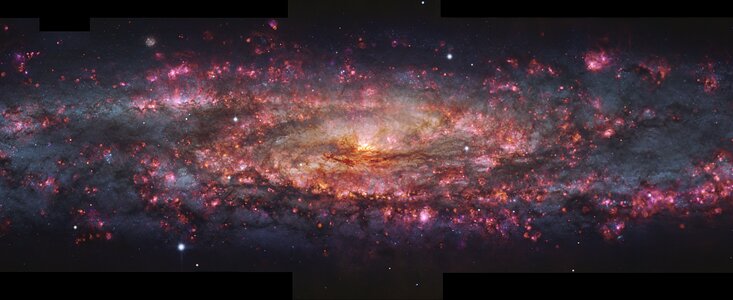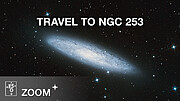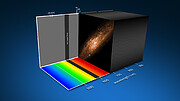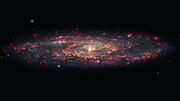Lehdistötiedote
Tähtitieteilijät ovat ottaneet galaksista erittäin tarkan tuhansista väreistä koostuvan kuvan
18. kesäkuuta 2025, Turku
Tähtitieteilijät ovat saaneet aikaan galaktisen mestariteoksen: hyvin yksityiskohtaisen kuvan, joka paljastaa Kuvanveistäjä-galaksissa ennennäkemättömiä piirteitä. Kuvan tekemisessä on käytetty Euroopan eteläisen observatorion (ESO) VLT-teleskooppia (ESO:n VLT). Tähtitieteilijät havaitsivat tätä läheistä galaksia samanaikaisesti tuhansissa eri väreissä. Tutkimuksessa tähtiten elämää on kartoitettu Kuvanveistäjä-galaksin alueen jokaisessa yksittäisessä pisteessä keräämällä yhteen valtava määrä informaatiota.
”Galaksit ovat uskomattoman monimutkaisia kokonaisuuksia, joiden ymmärtäminen on yhä vaikeaa”, sanoi ESO:n tutkija Enrico Congiu, joka johti uutta Kuvanveistäjä-galaksin Astronomy & Astrophysics -lehdessä julkaistua tutkimusta. Halkaisijaltaan satojen tuhansien valovuosien kokoiset galaksit ovat erittäin suuria, mutta niiden kehitys riippuu siitä, mitä tapahtuu paljon pienemmissä mittakaavoissa. ”Kuvanveistäjä-galaksi on juuri oikealla paikalla”, Congiu sanoi. ”Se on tarpeeksi lähellä, jotta sen sisäinen rakenne voidaan erottaa, ja sen koostumusta voidaan tutkia uskomattoman yksityiskohtaisesti. Samalla se on tarpeeksi suuri, jotta voimme silti nähdä sen yhtenä kokonaisuutena.”
Galaksin rakenneosat: tähdet, kaasu ja pöly emittoivat eri väristä valoa. Siksi mitä enemmän värisävyjä galaksin kuvassa on, sitä enemmän saamme tietoa sen sisäisestä toiminnasta. Värejä on tavallisesti kuvissa vain muutama, mutta tämä uusi kartta Kuvanveistäjästä koostuu tuhansista väreistä. Tämän ansiosta tähtitieteilijät tietävät kaiken, mitä heidän tarvitsee tietää galaksin sisällä olevista tähdistä, kaasusta ja pölystä, kuten niiden iästä, koostumuksesta ja liikkeestä.
Tämän kartan koostamiseksi tutkijat ovat havainneet kohdetta ESO:n VLT:n Multi Unit Spectroscopic Explorer, eli MUSE-instrumentilla yli 50 tunnin ajan. Galaksi sijaitsee 11 miljoonan valovuoden etäisyydellä, ja se tunnetaan myös nimellä NGC 253. Tutkimusryhmä kokosi yhteen yli 100 valotusta kattaakseen galaksista noin 65 000 valovuoden levyisen alueen.
Tutkimuksessa mukana olleen Kathryn Kreckelin (Heidelbergin yliopisto, Saksa) mukaan tämä tekee kartasta tehokkaan työkalun: ”Voimme zoomata eri alueisiin ja tutkia yksittäisiä alueita, joilla tähtiä muodostuu melkein yksittäisten tähtien mittakaavassa, mutta voimme myös zoomata ulospäin ja tutkia galaksia kokonaisuutena.”
Ensimmäisessä data-analyysissään tutkimusryhmä löysi Kuvanveistäjä-galaksista noin 500 planetaarista sumua, jotka koostuvat kuolevista auringonkaltaisista tähdistä irtoavasta kaasusta ja pölystä. Yksi tutkimuksen tekijöistä Fabian Scheuermann, tohtorikoulutettava Heidelbergin yliopistossa, suhteuttaa tätä lukua: ”Oman galaksimme ulkopuolella galaksia kohti havaintoja on yleensä alle 100.”
Planetaaristen sumujen ominaisuuksien vuoksi niitä voidaan käyttää isäntägalaksiensa etäisyyksien määrityksessä. ”Planetaaristen sumujen löytäminen auttaa meitä tarkistamaan galaksin etäisyyden, joka on kriittisen tärkeää tietoa, josta muut galaksista tehdyt tutkimukset riippuvat”, sanoi yhdysvaltalainen Ohio State Universityn professori Adam Leroy, joka on yksi tutkimuksen kirjoittajista.
Tulevissa karttaa hyödyntävissä hankkeissa tutkitaan, miten kaasu virtaa, muuttaa koostumustaan ja muodostaa tähtiä eri puolilla galaksia. ”On yhä mysteeri, miten näin pienillä prosesseilla voi olla näin suuri vaikutus galaksiin, jonka koko on tuhansia kertoja suurempi”, Congiu sanoi.
Lisätietoa
Tämä tutkimus on esitelty artikkelissa, joka on hyväksytty julkaistavaksi Astronomy & Astrophysics -lehdessä.
Tutkimuksessa mukana ovat olleet: E. Congiu (European Southern Observatory, Chile [ESO Chile]), F. Scheuermann (Astronomisches Rechen-Institut, Zentrum für Astronomie der Universität Heidelberg, Saksa [ARI-ZAH]), K. Kreckel (ARI-ZAH), A. Leroy (Department of Astronomy and Center for Cosmology and Astroparticle Physics, The Ohio State University [OSU], Yhdysvallat), E. Emsellem (European Southern Observatory, Saksa [ESO Garching] ja Univ. Lyon, Univ. Lyon1, ENS de Lyon, CNRS, Centre de Recherche Astrophysique de Lyon, Ranska), F. Belfiore (INAF – Osservatorio Astrofisico di Arcetri, Italia), J. Hartke (Finnish Centre for Astronomy with ESO [FINCA] ja Tuorlan observatorio, Department of Physics and Astronomy [Tuorla], Turun yliopisto, Suomi), G. Anand (Space Telescope Science Institute, Yhdysvallat), O. V. Egorov (ARI-ZAH), B. Groves (International Centre for Radio Astronomy Research, University of Western Australia, Australia), T. Kravtsov (Tuorla ja FINCA), D. Thilker (Department of Physics and Astronomy, The Johns Hopkins University, Yhdysvallat), C. Tovo (Dipartimento di Fisica e Astronomia ‘G. Galilei’, Universit‘a di Padova, Italia), F. Bigiel (Argelander-Institut für Astronomie, Universität Bonn, Germany), G. A. Blanc (Observatories of the Carnegie Institution for Science, Yhdysvallat, and Departamento de Astronomía, Universidad de Chile, Chile), A. D. Bolatto ja S. A. Cronin (Department of Astronomy, University of Maryland, Yhdysvallat), D. A. Dale (Department of Physics and Astronomy, University of Wyoming, Yhdysvallat), R. McClain (OSU), J. E. Méndez-Delgado (Instituto de Astronomía, Universidad Nacional Autónoma de México, Meksiko), E. K. Oakes (Department of Physics, University of Connecticut, Yhdysvallat), R. S. Klessen (Universität Heidelberg, Zentrum für Astronomie, Institut für Theoretische Astrophysik and Interdisziplinäres Zentrum für Wissenschaftliches Rechnen, Saksa, Center for Astrophysics Harvard & Smithsonian, Yhdysvallat, and Elizabeth S. and Richard M. Cashin Fellow at the Radcliffe Institute for Advanced Studies at Harvard University, Yhdysvallat) E. Schinnerer (Max-Planck-Institut für Astronomie, Saksa), T. G. Williams (Sub-department of Astrophysics, Department of Physics, University of Oxford, Yhdistynyt kuningaskunta).
Euroopan eteläinen observatorio (ESO) tekee maailmankaikkeuden salaisuuksien tutkimisen mahdolliseksi kaikille tutkijoille ympäri maailman. Suunnittelemme, rakennamme ja operoimme huippuluokan maanpäälisiä observatorioita, joita tähtitieteilijät käyttävät jännittävien tutkimusongelmien ratkaisemiseen ja populääritähtitieteen edistämiseen. Me edistämme myös kansainvälistä yhteistyötä tähtitieteen alalla. ESO perustettiin hallitustenväliseksi järjestöksi vuonna 1962 ja nykyään ESO:ssa on mukana 16 jäsenvaltiota (Itävalta, Belgia, Tšekki, Tanska, Ranska, Suomi, Saksa, Irlanti, Italia, Alankomaat, Puola, Portugali, Espanja, Ruotsi, Sveitsi ja Yhdistynyt kuningaskunta) yhdessä Chilen isäntävaltion kanssa ja Australian kanssa strategisena kumppanina. ESO:n pääkonttori ja sen vierailijakeskus ja planetaario, ESO Supernova, sijaitsevat lähellä Müncheniä Saksassa. Chilen Atacaman aavikko on upea paikka, jossa on ainutlaatuiset olosuhteet tähtitaivaan tarkkailuun. Se on kaukoputkiemme sijoituspaikka. ESO:lla on kolme havaintopaikkaa: La Silla, Paranal ja Chajnantor. Paranalissa ESO operoi Very Large Telescope (VLT) kaukoputkea ja siihen liittyvää Very Large Telescope Interferometria sekä paikalla sijaitsevia taivaankartoitusteleskooppeja: infrapuna-alueella toimivaa VISTAa ja näkyvän valon alueella toimivaa VLT Survey Teleskooppia. Paranalissa ESO isännöi ja operoi myös Cherenkov Telescope Array South havaintolaitetta, joka on maailman suurin ja herkin gamma-alueella havaitseva observatorio. ESO operoi yhdessä kansainvälisten kumppaneiden kanssa APEX- ja ALMA-observatriota Chajnantorilla, jotka ovat kaksi millimetri- ja alimillimetrin alueella toimivaa havaintolaitetta. Rakennamme parhaillaan Paranalin lähelle Cerro Armazonesille "maailman suurinta silmää taivaalle”, ESO:n Erittäin suurta kaukoputkea (Extremely Large Telescope, ELT). Santiagossa, Chilessä sijaitsevista toimipisteistämme tuemme toimintaamme Chilessä ja olemme yhteydessä chileläisiin yhteistyökumppaneihin ja yhteiskuntaan.
Linkit
- Tutkimusartikkeli
- VLT:n kuvia
- Median edustaja: saadaksesi julkaisut ennen niiden virallista julkaisemista tilaa uutiskirje omalla kielelläsi.
- Tutkija, onko sinulla kerrottavaa? Pitchaa oma tutkimuksesi.
- ESO:n uusi analyysi varmistaa, että maailman pimein ja selkein taivas on vaarassa teollisuuden megahankkeen vuoksi
Yhteystiedot
Enrico Congiu
European Southern Observatory (ESO)
Santiago, Chile
Sähköposti: econgiu@eso.org
Kathryn Kreckel
Heidelberg University
Heidelberg, Germany
Puh.: +49 6221 54-1859
Sähköposti: kathryn.kreckel@uni-heidelberg.de
Adam Leroy
The Ohio State University
Columbus, Ohio, USA
Puh.: +1 614 292-1765
Sähköposti: leroy.42@osu.edu
Fabian Scheuermann
Heidelberg University
Heidelberg, Germany
Sähköposti: f.scheuermann@uni-heidelberg.de
Bárbara Ferreira
ESO Media Manager
Germany, Germany
Puh.: +49 89 3200 6670
Matkapuhelin: +49 151 241 664 00
Sähköposti: press@eso.org
Pasi Nurmi (Lehdistön yhteyshenkilö Suomi)
ESO Science Outreach Network
ja University of Turku
Turku, Finland
Puh.: +358 29 4504 358
Sähköposti: eson-finland@eso.org
Tiedotteesta
| Tiedote nr.: | eso2510fi |
| Nimi: | NGC 253, Sculptor Galaxy |
| Tyyppi: | Local Universe : Galaxy : Type : Barred |
| Facility: | Very Large Telescope |
| Instruments: | MUSE |
| Science data: | 2025A&A...700A.125C |
Our use of Cookies
We use cookies that are essential for accessing our websites and using our services. We also use cookies to analyse, measure and improve our websites’ performance, to enable content sharing via social media and to display media content hosted on third-party platforms.
ESO Cookies Policy
The European Organisation for Astronomical Research in the Southern Hemisphere (ESO) is the pre-eminent intergovernmental science and technology organisation in astronomy. It carries out an ambitious programme focused on the design, construction and operation of powerful ground-based observing facilities for astronomy.
This Cookies Policy is intended to provide clarity by outlining the cookies used on the ESO public websites, their functions, the options you have for controlling them, and the ways you can contact us for additional details.
What are cookies?
Cookies are small pieces of data stored on your device by websites you visit. They serve various purposes, such as remembering login credentials and preferences and enhance your browsing experience.
Categories of cookies we use
Essential cookies (always active): These cookies are strictly necessary for the proper functioning of our website. Without these cookies, the website cannot operate correctly, and certain services, such as logging in or accessing secure areas, may not be available; because they are essential for the website’s operation, they cannot be disabled.
Functional Cookies: These cookies enhance your browsing experience by enabling additional features and personalization, such as remembering your preferences and settings. While not strictly necessary for the website to function, they improve usability and convenience; these cookies are only placed if you provide your consent.
Analytics cookies: These cookies collect information about how visitors interact with our website, such as which pages are visited most often and how users navigate the site. This data helps us improve website performance, optimize content, and enhance the user experience; these cookies are only placed if you provide your consent. We use the following analytics cookies.
Matomo Cookies:
This website uses Matomo (formerly Piwik), an open source software which enables the statistical analysis of website visits. Matomo uses cookies (text files) which are saved on your computer and which allow us to analyze how you use our website. The website user information generated by the cookies will only be saved on the servers of our IT Department. We use this information to analyze www.eso.org visits and to prepare reports on website activities. These data will not be disclosed to third parties.
On behalf of ESO, Matomo will use this information for the purpose of evaluating your use of the website, compiling reports on website activity and providing other services relating to website activity and internet usage.
Matomo cookies settings:
Additional Third-party cookies on ESO websites: some of our pages display content from external providers, e.g. YouTube.
Such third-party services are outside of ESO control and may, at any time, change their terms of service, use of cookies, etc.
YouTube: Some videos on the ESO website are embedded from ESO’s official YouTube channel. We have enabled YouTube’s privacy-enhanced mode, meaning that no cookies are set unless the user actively clicks on the video to play it. Additionally, in this mode, YouTube does not store any personally identifiable cookie data for embedded video playbacks. For more details, please refer to YouTube’s embedding videos information page.
Cookies can also be classified based on the following elements.
Regarding the domain, there are:
- First-party cookies, set by the website you are currently visiting. They are stored by the same domain that you are browsing and are used to enhance your experience on that site;
- Third-party cookies, set by a domain other than the one you are currently visiting.
As for their duration, cookies can be:
- Browser-session cookies, which are deleted when the user closes the browser;
- Stored cookies, which stay on the user's device for a predetermined period of time.
How to manage cookies
Cookie settings: You can modify your cookie choices for the ESO webpages at any time by clicking on the link Cookie settings at the bottom of any page.
In your browser: If you wish to delete cookies or instruct your browser to delete or block cookies by default, please visit the help pages of your browser:
Please be aware that if you delete or decline cookies, certain functionalities of our website may be not be available and your browsing experience may be affected.
You can set most browsers to prevent any cookies being placed on your device, but you may then have to manually adjust some preferences every time you visit a site/page. And some services and functionalities may not work properly at all (e.g. profile logging-in, shop check out).
Updates to the ESO Cookies Policy
The ESO Cookies Policy may be subject to future updates, which will be made available on this page.
Additional information
For any queries related to cookies, please contact: pdprATesoDOTorg.
As ESO public webpages are managed by our Department of Communication, your questions will be dealt with the support of the said Department.








